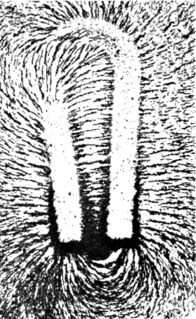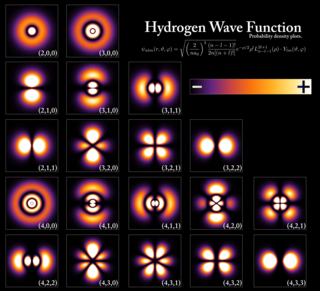In quantum mechanics, a Hamiltonian is an operator corresponding to the sum of the kinetic energies plus the potential energies for all the particles in the system. It is usually denoted by H, also Ȟ or Ĥ. Its spectrum is the set of possible outcomes when one measures the total energy of a system. Because of its close relation to the time-evolution of a system, it is of fundamental importance in most formulations of quantum theory.
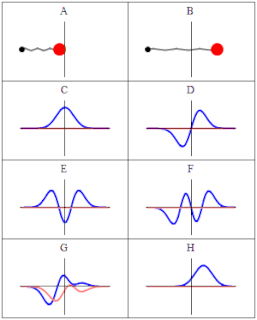
The quantum harmonic oscillator is the quantum-mechanical analog of the classical harmonic oscillator. Because an arbitrary potential can usually be approximated as a harmonic potential at the vicinity of a stable equilibrium point, it is one of the most important model systems in quantum mechanics. Furthermore, it is one of the few quantum-mechanical systems for which an exact, analytical solution is known.

The Schrödinger equation is a linear partial differential equation that describes the wave function or state function of a quantum-mechanical system. It is a key result in quantum mechanics, and its discovery was a significant landmark in the development of the subject. The equation is named after Erwin Schrödinger, who derived the equation in 1925, and published it in 1926, forming the basis for the work that resulted in his Nobel Prize in Physics in 1933.

The Aharonov–Bohm effect, sometimes called the Ehrenberg–Siday–Aharonov–Bohm effect, is a quantum mechanical phenomenon in which an electrically charged particle is affected by an electromagnetic potential, despite being confined to a region in which both the magnetic field B and electric field E are zero. The underlying mechanism is the coupling of the electromagnetic potential with the complex phase of a charged particle's wave function, and the Aharonov–Bohm effect is accordingly illustrated by interference experiments.
In physics, an operator is a function over a space of physical states to another space of physical states. The simplest example of the utility of operators is the study of symmetry. Because of this, they are very useful tools in classical mechanics. Operators are even more important in quantum mechanics, where they form an intrinsic part of the formulation of the theory.
The magnetic quantum number is one of four quantum numbers in atomic physics. The set is: principal quantum number, azimuthal quantum number, magnetic quantum number, and spin quantum number. Together, they describe the unique quantum state of an electron. The magnetic quantum number distinguishes the orbitals available within a subshell, and is used to calculate the azimuthal component of the orientation of orbital in space. Electrons in a particular subshell are defined by values of ℓ. The value of ml can range from -ℓ to +ℓ, inclusive of zero. Thus the s, p, d, and f subshells contain 1, 3, 5, and 7 orbitals each, with values of m within the ranges 0, ±1, ±2, ±3 respectively. Each of these orbitals can accommodate up to two electrons, forming the basis of the periodic table.
In quantum mechanics (physics), the canonical commutation relation is the fundamental relation between canonical conjugate quantities. For example,
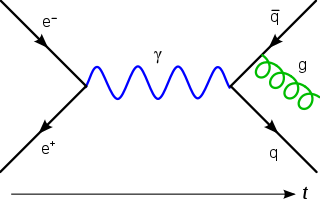
In physics, canonical quantization is a procedure for quantizing a classical theory, while attempting to preserve the formal structure, such as symmetries, of the classical theory, to the greatest extent possible.
Conjugate variables are pairs of variables mathematically defined in such a way that they become Fourier transform duals, or more generally are related through Pontryagin duality. The duality relations lead naturally to an uncertainty relation—in physics called the Heisenberg uncertainty principle—between them. In mathematical terms, conjugate variables are part of a symplectic basis, and the uncertainty relation corresponds to the symplectic form. Also, conjugate variables are related by Noether's theorem, which states that if the laws of physics are invariant with respect to a change in one of the conjugate variables, then the other conjugate variable will not change with time.
In quantum physics, the spin–orbit interaction is a relativistic interaction of a particle's spin with its motion inside a potential. A key example of this phenomenon is the spin–orbit interaction leading to shifts in an electron's atomic energy levels, due to electromagnetic interaction between the electron's magnetic dipole, its orbital motion, and the electrostatic field of the positively charged nucleus. This phenomenon is detectable as a splitting of spectral lines, which can be thought of as a Zeeman effect product of two relativistic effects: the apparent magnetic field seen from the electron perspective and the magnetic moment of the electron associated with its intrinsic spin. A similar effect, due to the relationship between angular momentum and the strong nuclear force, occurs for protons and neutrons moving inside the nucleus, leading to a shift in their energy levels in the nucleus shell model. In the field of spintronics, spin–orbit effects for electrons in semiconductors and other materials are explored for technological applications. The spin–orbit interaction is one cause of magnetocrystalline anisotropy and the spin Hall effect.
In quantum mechanics, the momentum operator is the operator associated with the measurement of linear momentum. The momentum operator is, in the position representation, an example of a differential operator. For the case of one particle in one dimension, the definition is:
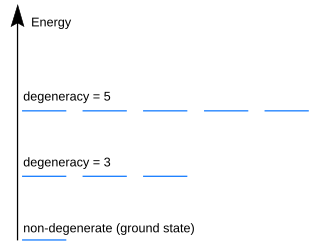
In quantum mechanics, an energy level is degenerate if it corresponds to two or more different measurable states of a quantum system. Conversely, two or more different states of a quantum mechanical system are said to be degenerate if they give the same value of energy upon measurement. The number of different states corresponding to a particular energy level is known as the degree of degeneracy of the level. It is represented mathematically by the Hamiltonian for the system having more than one linearly independent eigenstate with the same energy eigenvalue. In classical mechanics, this can be understood in terms of different possible trajectories corresponding to the same energy.
In quantum mechanics, the probability current is a mathematical quantity describing the flow of probability in terms of probability per unit time per unit area. Specifically, if one describes the probability density as a heterogeneous fluid, then the probability current is the rate of flow of this fluid. This is analogous to mass currents in hydrodynamics and electric currents in electromagnetism. It is a real vector, like electric current density. The concept of a probability current is a useful formalism in quantum mechanics.
In quantum mechanics, the angular momentum operator is one of several related operators analogous to classical angular momentum. The angular momentum operator plays a central role in the theory of atomic physics and other quantum problems involving rotational symmetry. In both classical and quantum mechanical systems, angular momentum is one of the three fundamental properties of motion.
In quantum mechanics, the position operator is the operator that corresponds to the position observable of a particle.
Landau quantization in quantum mechanics is the quantization of the cyclotron orbits of charged particles in magnetic fields. As a result, the charged particles can only occupy orbits with discrete energy values, called Landau levels. The Landau levels are degenerate, with the number of electrons per level directly proportional to the strength of the applied magnetic field. Landau quantization is directly responsible for oscillations in electronic properties of materials as a function of the applied magnetic field. It is named after the Soviet physicist Lev Landau.
The theoretical and experimental justification for the Schrödinger equation motivates the discovery of the Schrödinger equation, the equation that describes the dynamics of nonrelativistic particles. The motivation uses photons, which are relativistic particles with dynamics described by Maxwell's equations, as an analogue for all types of particles.

Symmetries in quantum mechanics describe features of spacetime and particles which are unchanged under some transformation, in the context of quantum mechanics, relativistic quantum mechanics and quantum field theory, and with applications in the mathematical formulation of the standard model and condensed matter physics. In general, symmetry in physics, invariance, and conservation laws, are fundamentally important constraints for formulating physical theories and models. In practice, they are powerful methods for solving problems and predicting what can happen. While conservation laws do not always give the answer to the problem directly, they form the correct constraints and the first steps to solving a multitude of problems.
In pure and applied mathematics, quantum mechanics and computer graphics, a tensor operator generalizes the notion of operators which are scalars and vectors. A special class of these are spherical tensor operators which apply the notion of the spherical basis and spherical harmonics. The spherical basis closely relates to the description of angular momentum in quantum mechanics and spherical harmonic functions. The coordinate-free generalization of a tensor operator is known as a representation operator.

